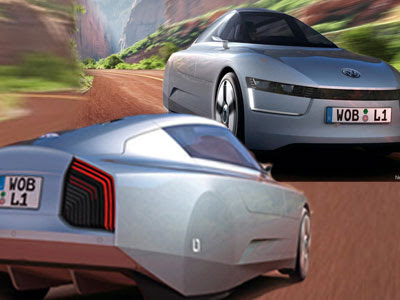
Volkswagen L1 Concept
In the world today the Volkswagen L1 Concept is unique. Thanks to a carbon fibre reinforced plastic (CFRP) body, it weighs just 380 kilograms. The two-seater is powered by a new common rail turbo-diesel (two-cylinder TDI) and an electric motor. With its average fuel consumption of 1.49 litres diesel per 100 kilometres, this fully road-ready and extremely aerodynamic L1 (Cd 0.195!) is advancing to become the most fuel-efficient hybrid automobile in the world. CO2 emissions of the 160 km/h fast concept car are just 39 g/km. If the Volkswagen L1 were to also go into production in 2013, it would debut an entirely new lightweight car concept and introduce a new era in automotive production.
The TDI, E-motor and 7-speed DSG are located at the rear, and they combine to create the most fuel efficient road-legal car hybrid drive in the world. Proof of this are its 1.38 litre per 100 kilometres fuel consumption and 36 g/km CO2 emissions.Naturally, the Volkswagen L1 also has a Stop-Start system that automatically shuts down the engine when vehicle has stopped and restarts when the accelerator or E-pedal is pressed.
The TDI engine in the Volkswagen L1 Concept is a new development. Yet, even here Volkswagen has been able to exploit synergies to design an engine that is both innovative and cost-effective.
Gear shifting work aboard the Volkswagen L1 is handled by the 7-speed DSG, which is one of the most innovative automatic transmissions in production.
The Volkswagen L1, equipped with ABS and ESP, has a top speed of up to 160 km/h - this is remarkable considering its fuel efficiency. With maximum acceleration from a standstill, the two-seater reaches 100 km/h after just 14.3 seconds. The fuel tank holds just ten litres yet, this is sufficient for a theoretical driving range of about 670 kilometres, given the car's 1.38 litre average fuel consumption.

Volkswagen L1 Concept
Talking about car driving as 'piloting' might sound out of place, but in the case of the Volkswagen L1 it is wholly appropriate. The driver (in the CFRP tube frame seat) and passenger (in the fixed CFRP seat that is part of the monocoque) sit one behind the other.
To start the Volkswagen L1, the driver pushes a button on the right side of the steering wheel. When it is rotated, the round start button simultaneously serves as a gear selector switch and is used to activate the electronic handbrake (Drive, Neutral, Reverse and Park). The entry canopy and rear hatch are opened electrically by touch controls to the left and right of the driver. Also designed as touch sensors are controls for the entire air conditioning control system. Via multifunctional keys in the steering wheel, the driver controls the on-board computer, navigation and entertainment systems.
The classic door mirror and rear-view mirror have been completely eliminated on the Volkswagen L1. In their place, cameras display images on OLED-active (OLED = organic light emitting diode) displays located on the left and right sides of the instrument panel. A Park Distance Control (PDC) system makes parking easier as well.
Both technically and visually, the CFRP body is already a significant achievement in car design. Unique on this car: the proportions of its dimensions. While the length of the Volkswagen L1 at 3,813 millimetres is still similar to that of a Volkswagen Fox, and its height of 1,143 millimetres nearly matches that of a Lamborghini Murciélago, the car's aerodynamically optimised width (1,200 millimetres) has no comparisons in the world of today's production cars.
The two-seat monocoque, including the tubular frame driver's seat and passenger seat as well as the exterior body skin, all consist of CFRP. There are no doors. Instead, the driver and passenger climb into the Volkswagen L1 from the top.
The reason that CFRP is the ideal material for the Volkswagen L1 body is demonstrated by considering its weight and strength.
And there are other advantages: the material's extremely high stress limits and its ideal forming properties for even the most challenging of design features.
The design and styling of the Volkswagen L1 Concept - function and form - combine to form one uncompromising unit. Walter de Silva, Head of Design for the Volkswagen Group has this to say: "The design of the Volkswagen L1 redefines classic and aesthetic vehicle traits. Especially significant, of course, is how the nearly rocket-shaped lines catch one's attention. All of its moving parts are integrated so accurately that the body resembles a rocket or jet. It is a body that cuts through the air with minimal aerodynamic resistance."





0 comments:
Post a Comment